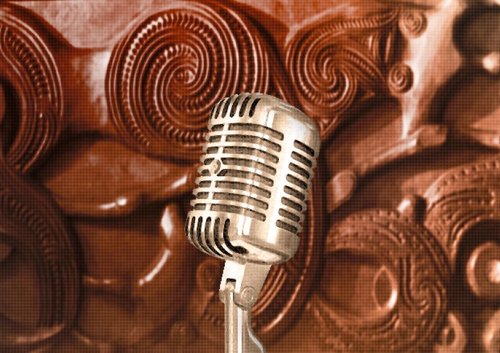
Ka tuhia e Ngā Taonga te reo Māori hei āwhina i ngā iwi ki te kimi taonga, me te mōhio ana hoki e arahina ana mātou e ngā reo o ngā tūpuna i ngā kohinga.
Kua kitea e ā mātou kaimahi te hōhonu o ngā kohinga hei āwhina i a mātou ki te pupuri i te reo tūturu, hei tuhinga mā mātou ināianei rangi, ka toitū tonu aua reo o inanahi. Ka tuku tīhau te Pūranga nei ki roto i te reo o ngā tau 1980, ana ka whakamahia taua reo ki ngā āhuatanga o ēnei rā.
Kua tuhia e te Poutaki Taonga Māori, e Gareth Seymour, e pā ana ki ngā kohinga ataata-rongo me te reo e puritia ana i konā hei ako i te reo rangatira, ka whakarārangihia aua kōrero, ka puta anō aua kōrero ki te ao mārama, ka puta tahi aua mātauranga Māori ki roto i ngā whakamārama.
———
When Ngā Taonga produces written Māori language content to aid collection finding, what we write is often guided by the tupuna voices that are held in our collections.
We’ve discovered that the collection is a great resource to help to maintain ‘traditional’ Māori language, that what we write in Māori today can reflect the voices of yesterday. As an archive we can tweet in the language of the 1980s, while adapting that language to modern situations and events.
Poutaki Taonga Māori Gareth Seymour writes about how audiovisual taonga are both a keeper and teacher of te reo rangatira, and how cataloguing both unlocks and informs the way we express mātauranga Māori as metadata.
Recycling kupu Māori
How do the collections help us to learn and recycle ‘new’ words and sentence structures?
While researching, we dedicate time to watching Māori radio and television programmes from the 1970s and 1980s. Each programme can help us to describe a modern story such as the highs and lows of the annual budget, or a kaupapa on the whenua. It’s surprising how similar Māori news stories are some three or four decades apart. The issues covered are often identical, with only people and locations changing.
In the 1980s, Māori were holding wānanga, challenging their local councils, developing reo programmes and responding to new government policies. All of these types of stories exist today. The way they were reported in the 1980s provides a template for adequately describing the issue in archival terms, while staying true to the language used at the time.
Here are two examples:
‘Kei te wera ētahi Māori o …’
This phrase was used on a Māori news programme in 1986 about iwi riri over land issues. It’s a uniquely Māori way of expressing their concern. People don’t really use this phrase any more as they now use verbs such as whakahē or porotēhe in reference to disputes. Now that Ngā Taonga archivists have discovered this phrase we will add it to our kete kōrero and use it sometimes to describe news stories where people are passionate about something.
‘Te Tonga o Āwherika’
Ngā Taonga is doing some work to commemorate the Springbok Tour of 1981. We’ve digitally scanned PATU!, the documentary about opposition to the tour, and opened an exhibition TOHE | PROTEST. To help build our vocabulary for this kaupapa, we reviewed Māori language commentary about the Springboks from the 1970s and 1980s.
One useful term from the past is ‘Te Tonga o Āwherika’ for South Africa which has morphed today to ‘Āwherika ki te Tonga.’ To stay true to this ‘traditional’ version of the name, our Tour exhibition will refer to the name for South Africa that was used in the 1970s and 1980s.
We’re using this approach for all of our writing in te reo Māori, including social media, cataloguing, report writing, exhibition panels and event invitations.
Ngā Taonga is an audiovisual archive with rich holdings of spoken Māori language from previous decades. Much of our collection sits on analogue formats, and we have plans in place for mass digitisation of these taonga in the years ahead through our Utaina project.
Ngā Taonga archivists will continue to develop language skills by exploring the ways that our audiovisual taonga reveal how our uncles, aunties, nannies and koro explained their world. Their recorded language has become a driver for the way we make taonga ‘findable’ in our online catalogue, and in our sharing and promotion of te reo rangatira.
You can explore these taonga too
You can discover more examples of ‘traditional Māori language’ yourself by exploring our online collection. Find exemplary Māori language material from your rohe, playable on your device, by searching key terms such as names of iwi, people and places.
Nō reira tūhuratia, we invite you to explore our collections today.
Hero image: A silver microphone against a background of Māori carvings.